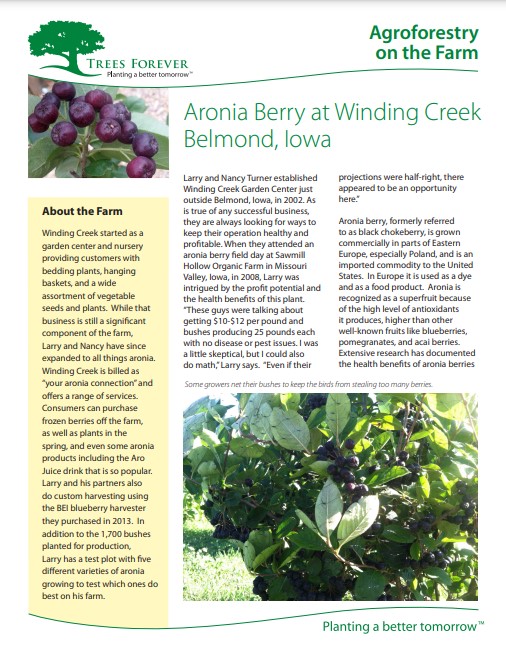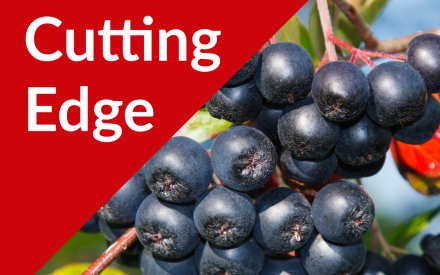Aronia Berries

ARONIA BERRIES
Crop Profile
Get Involved!
Aronia berry (Aronia melanocarpa), also known as black chokeberry, is a deciduous shrub native to eastern North America, including Wisconsin. It is grown as both a food crop and an ornamental, valued for its edible black berries produced in late summer/early fall, white flowers in spring and reddish fall foliage. The berries are extremely high in antioxidants and processed into a variety of nutraceutical and food products including health supplements, juice, jelly, and syrup. Their deep purple color also makes them useful as a food colorant.
Aronia is a relatively new food crop in the United States but has been grown commercially in Russia and Eastern Europe since the 1940s. Poland is the world’s largest producer of aronia berries. Interest in the crop is mainly due to its “superfood” status. Aronia has more antioxidants (anthocyanins and flavonoids) than any other temperate fruit, nearly three times that of blueberries. The high levels of antioxidants give the berry an astringent flavor when eaten fresh, hence the name chokeberry, but they are much more palatable when used in processed products.
Production
Aronia berries are an attractive perennial crop option. They are highly productive, tolerate a wide range of growing conditions, and have few pest and disease issues. Plants grow to be about 4-8′ tall and produce suckers. Pruning is recommended every few years to remove old canes. Clusters of white flowers appear in early May and fruit ripen beginning in late August. Plants begin to produce berries in their second or third year, but significant yields are not achieved until years four or five. Aronia are most commonly propagated by seed or cuttings. Plants are self-fruitful and do not require more than one variety for fruit set.
Yields average approximately 15-20lbs per plant and plants can produce more than 10,000lbs on a per acre basis. Plants can be hand-harvested but mechanical harvesting is usually required to produce the volume needed to make this a viable crop option. Commercial, over-row blueberry harvesters work well for aronia. When mechanical harvesting, plants are spaced 3-4′ within rows and allowed to grow into a hedgerow. 12-14′ is recommended between rows. Berries are firm and hold up well during harvesting, processing and handling. After harvest, berries need to be refrigerated in storage before being processed.
For more details on aronia production, visit the University of Maine Cooperative Extension.
Research Status and Priorities
Aronia has a long history of research and breeding as an ornamental crop in the United States, but interest in it as a food crop is relatively recent. Eastern Europe and Russia, on the other hand, have a long history of growing aronia for berry production with significant breeding programs going back to the late 1800s and early 1900s. As a result, the varieties commonly grown for berries in the United States today were all developed overseas. However, there are a few research and breeding programs working on aronia as an agricultural crop in the United States.
One of the major challenges in breeding aronia as a food crop is highly the homogenous gene pool in domesticated plant material (there are really only two distinct varieties in cultivation, ‘Viking’ and ‘Nero’). The breeding program at the University of Connecticut has focused on broadening the genetic basis of the germplasm by intercrossing wild aronia with domesticated forms. Its primary goal is to improve aronia by increasing levels of antioxidants and anticancer compounds in the berries. Secondary goals include selecting for traits such as berry size, flavor, yield, plant form, and disease resistance.
The University of Maryland has an active orchard and has been conducting agronomic research on the crop for over a decade. Their research has focused mainly on production practices such as fertilization, irrigation needs, and plant density. They have also studied the effect of conventional versus organic fertilizers on crop yield and fruit quality.
Other research has largely focused on the health benefits of the berries. These studies have analyzed the phenolic profile and antioxidant potential of the fruit and their implications on human health, including prevention of chronic diseases such as diabetes, cancer and cardiovascular disease. The American Aronia Berry Association compiles a list of publications on their website.
Markets
Direct marketing of aronia berries to consumers is a challenge because of the astringency of the fresh berries. There may be a limited market at farmers markets, co-ops and other health food stores, but most berries are sold wholesale to processors who freeze, freeze-dry, or convert the berries into juice, concentrate, or powder. These are then used in a wide variety of value-added products marketed to health conscious consumers, such as syrups, juices (and juice concentrates), jellies, extracts, powders, teas, wines, gummies, vinegars, and health food snacks.
Wholesale prices for fresh or frozen berries range from $0.50-$1.25 per pound but can vary widely depending on the buyer. Organizations such as the American Aronia Berry Association and National Aronia Growers provide valuable resources to growers and sellers of aronia products. Aronia berries remain a niche product and prospective growers are encouraged to explore their own markets before planting.
Plant Material
The University of Maine Cooperative Extension website has a list of nurseries from around the country that sell aronia plants. When selecting cultivars for food production, avoid those with red berries, known as red chokeberries (Aronia arbutifolia), which are grown for ornamental purposes. Among black fruited cultivars (Aronia melanocarpa), some were selected for ornamental qualities, such as plant stature and fall foliage color, while others were selected for agronomic qualities, such as berry size and productivity. Though all Aronia melanocarpa cultivars can be harvested for their berries, those bred for their agronomic traits will produce the highest quality berries and greatest yields. The two most common cultivars grown for berry production are ‘Viking’ and ‘Nero’, which have large, relatively sweet berries. ‘Galicjanka’ is another productive variety and the most commonly grown in Poland, where it was bred, but it is more difficult to find in the United States. Some nurseries sell aronia seedlings, which should be avoided for commercial scale plantings as each plant may be slightly different.
Resources and information
Read
In addition to the publications provided here, the University of Maine Cooperative Extension and the University of Maryland Extension have good information on their websites. Iowa State University’s Leopold Center for Sustainable Agriculture has several informative publications, as do the Savanna Institute and Trees Forever.
Watch
Listen
More Resources
American Aronia Berry Association (formerly Midwest Aronia Association)
North Dakota State University
University of Maine Cooperative Extension
University of Maryland Extension
University of Wisconsin-Madison Fruit and Nut Compass (financial planning tool)
Wisconsin Berry and Vegetable Growers Associations









